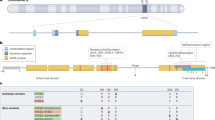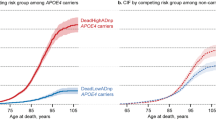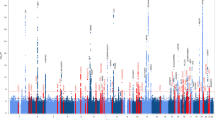Abstract
Risk alleles for age-related diseases are expected to decrease in frequency in the population strata of increasing age. Consistent with this hypothesis, earlier studies showed a depletion of the Alzheimer's disease risk factor APOE*ɛ4 in long-lived individuals (LLIs). To evaluate whether this observation also holds for a previously suggested Alzheimer's disease risk haplotype in the A2M gene, we analyzed this particular haplotype in 1042 German LLIs (aged 95–100 years) and 1040 younger individuals (aged 60–75 years). Our results show a significant depletion of this haplotype in LLIs, thus confirming it as a mortality factor in the elderly. Consequently, our data support an involvement of the suggested A2M risk haplotype in the pathogenesis of Alzheimer's disease and adds new evidence to the risk-allele depletion hypothesis.
Similar content being viewed by others
Log in or create a free account to read this content
Gain free access to this article, as well as selected content from this journal and more on nature.com
or
References
Blacker D, Wilcox MA, Laird NM et al: Alpha-2 macroglobulin is genetically associated with Alzheimer disease. Nat Genet 1998; 19: 357–360.
Liao A, Nitsch RM, Greenberg SM et al: Genetic association of an alpha2-macroglobulin (Val1000lle) polymorphism and Alzheimer's disease. Hum Mol Genet 1998; 7: 1953–1956.
Saunders AJ, Bertram L, Mullin K et al: Genetic association of Alzheimer's disease with multiple polymorphisms in alpha-2-macroglobulin. Hum Mol Genet 2003; 12: 2765–2776.
Panza F, Colacicco AM, D'Introno A et al: Candidate genes for late-onset Alzheimer's disease: focus on chromosome 12. Mech Ageing Dev 2006; 127: 36–47.
Ghebremedhin E, Schultz C, Thal DR, Del Tredici K, Rueb U, Braak H : Genetic association of argyrophilic grain disease with polymorphisms in alpha-2 macroglobulin and low-density lipoprotein receptor-related protein genes. Neuropathol Appl Neurobiol 2002; 28: 308–313.
Probst A, Tolnay M : Argyrophilic grain disease (AgD), a frequent and largely underestimated cause of dementia in old patients. Rev Neurol (Paris) 2002; 158: 155–165.
Corder EH, Saunders AM, Strittmatter WJ et al: Gene dose of apolipoprotein E type 4 allele and the risk of Alzheimer's disease in late onset families. Science 1993; 261: 921–923.
Koster MN, Dermaut B, Cruts M et al: The alpha2-macroglobulin gene in AD: a population-based study and meta-analysis. Neurology 2000; 55: 678–684.
Verpillat P, Bouley S, Hannequin D et al: Alpha2-macroglobulin gene and Alzheimer's disease: confirmation of association by haplotypes analyses. Ann Neurol 2000; 48: 400–402.
Hitt R, Young-Xu Y, Silver M, Perls T : Centenarians: the older you get, the healthier you have been. Lancet 1999; 354: 652.
Evert J, Lawler E, Bogan H, Perls T : Morbidity profiles of centenarians: survivors, delayers, and escapers. J Gerontol A Biol Sci Med Sci 2003; 58: 232–237.
Christensen K, Johnson TE, Vaupel JW : The quest for genetic determinants of human longevity: challenges and insights. Nat Rev Genet 2006; 7: 436–448.
Perls T, Kunkel LM, Puca AA : The genetics of exceptional human longevity. J Am Geriatr Soc 2002; 50: 359–368.
Flachsbart F, Caliebe A, Kleindorp R et al: Association of FOXO3A variation with human longevity confirmed in German centenarians. Proc Natl Acad Sci USA 2009; 106: 2700–2705.
Purcell S, Neale B, Todd-Brown K et al: PLINK: a tool set for whole-genome association and population-based linkage analyses. Am J Hum Genet 2007; 81: 559–575.
Nebel A, Croucher PJ, Stiegeler R, Nikolaus S, Krawczak M, Schreiber S : No association between microsomal triglyceride transfer protein (MTP) haplotype and longevity in humans. Proc Natl Acad Sci USA 2005; 102: 7906–7909.
R Development Core Team: A Language and Environment for Statistical Computing. R Foundation for Statistical Computing: Vienna, Austria, ISBN 3-900051-07-0 2008, URL http://www.R-project.org.
Dudbridge F : Pedigree disequilibrium tests for multilocus haplotypes. Genet Epidemiol 2003; 25: 115–121.
Schaid DJ, Rowland CM, Tines DE, Jacobson RM, Poland GA : Score tests for association between traits and haplotypes when linkage phase is ambiguous. Am J Hum Genet 2002; 70: 425–434.
Franceschi C, Bonafé M : Centenarians as a model for healthy aging. Biochem Soc Trans 2003; 31: 457–461.
Acknowledgements
We thank all study participants for their cooperation. We acknowledge the laboratory personnel of the Institute of Clinical Molecular Biology for excellent technical assistance and the staff of the Popgen Biobank for expert help with the sample recruitment. This study was supported by the DFG excellence cluster ‘Inflammation at Interfaces’ and the German Ministry of Education and Research (BMBF) through the National Genome Research Network (NGFN-2).
Author information
Authors and Affiliations
Corresponding author
Rights and permissions
About this article
Cite this article
Flachsbart, F., Caliebe, A., Nothnagel, M. et al. Depletion of potential A2M risk haplotype for Alzheimer's disease in long-lived individuals. Eur J Hum Genet 18, 59–61 (2010). https://doi.org/10.1038/ejhg.2009.136
Received:
Revised:
Accepted:
Published:
Issue date:
DOI: https://doi.org/10.1038/ejhg.2009.136
Keywords
This article is cited by
-
Association between genetic variants in the Coenzyme Q10 metabolism and Coenzyme Q10 status in humans
BMC Research Notes (2011)



